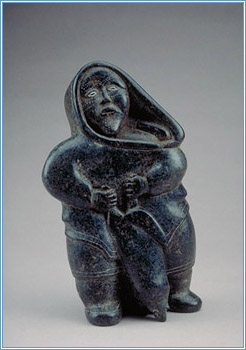

Woman with Fox Trapping foxes and trading them for staples such as tea, flour, rifles and ammunition became an important part of the Inuit economy after World War I. The Hudson's Bay Company established trading posts throughout the Arctic in response to the high demand for white fox. The fox population, however, rose and fell in five-year cycles, which caused recurrent periods of hardship and deprivation. After World War II, the price of fox pelts began to drop, contributing to the decline of the nomadic lifestyle of the Inuit. Art soon replaced furs in the Inuit economy. Instead of harvesting skins, the Inuit produced carvings for trade.    |